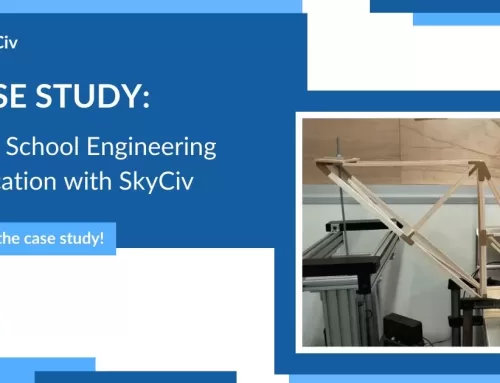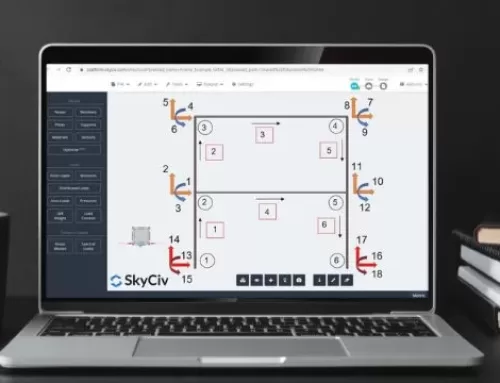What is Buckling and How is it Different From Bending/Deflection?
Buckling is the failure mode of a structural member experiencing high compressive stresses that cause a sudden sideways deflection. Columns are usually subjected to buckling checks because compressive or axial forces are responsible for buckling and these are common in columns rather than beams.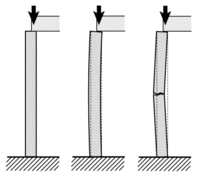 In structural engineering, the term "deflection" is usually reserved for a member's displacement due to bending forces. Deflection in this manner is predictable and can be calculated. On the other hand, the lateral deflection caused by buckling is unstable. Once a member begins to buckle, any further load will cause significant and unpredictable deformations. You can solve simulate simple column buckling with out column buckling calculator.
The image below shows a buckled member due to a high compressive load. Buckling often looks similar to crumpling (imagine squashing an empty can of soda).
In structural engineering, the term "deflection" is usually reserved for a member's displacement due to bending forces. Deflection in this manner is predictable and can be calculated. On the other hand, the lateral deflection caused by buckling is unstable. Once a member begins to buckle, any further load will cause significant and unpredictable deformations. You can solve simulate simple column buckling with out column buckling calculator.
The image below shows a buckled member due to a high compressive load. Buckling often looks similar to crumpling (imagine squashing an empty can of soda).
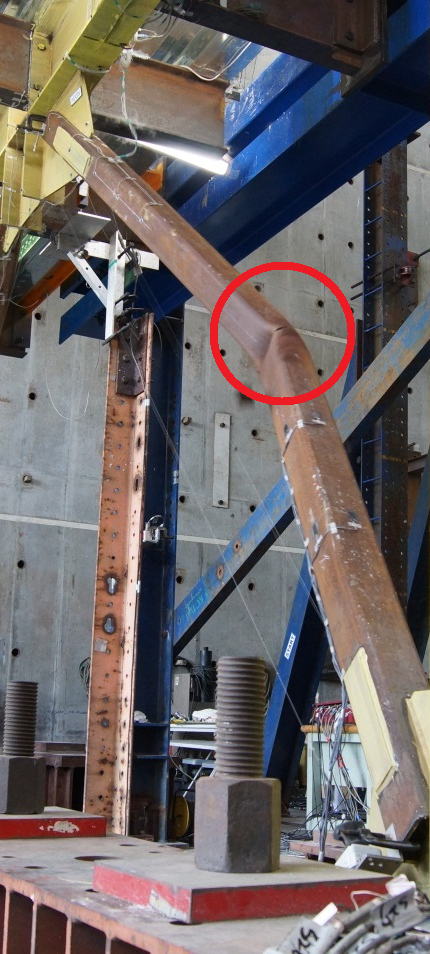
Performing a Buckling Analysis
SkyCiv Structural 3D can perform a buckling analysis for you. There are many cases where a linear static analysis is not adequate and such an analysis WILL NOT detect failure due to buckling. For this reason, a buckling analysis needs to be performed separately. Structural analysis software such as SkyCiv Structural 3D will give you the lowest buckling factor of the structure. Typically, a buckling factor of less than one indicates buckling would be occurring. Factors above one imply that the structure will not buckle, but it is wise to aim for a much higher buckling factor for obvious reasons. The example shown below illustrates how a linear static analysis solves for a very low deflection of the structure, even though buckling is occurring. Consider the four-story frame which is 22m tall. We have intentionally lengthened the bottom columns, which are fully fixed at the base to induce buckling. There are distributed loads on every level of the structure and self weight has been applied.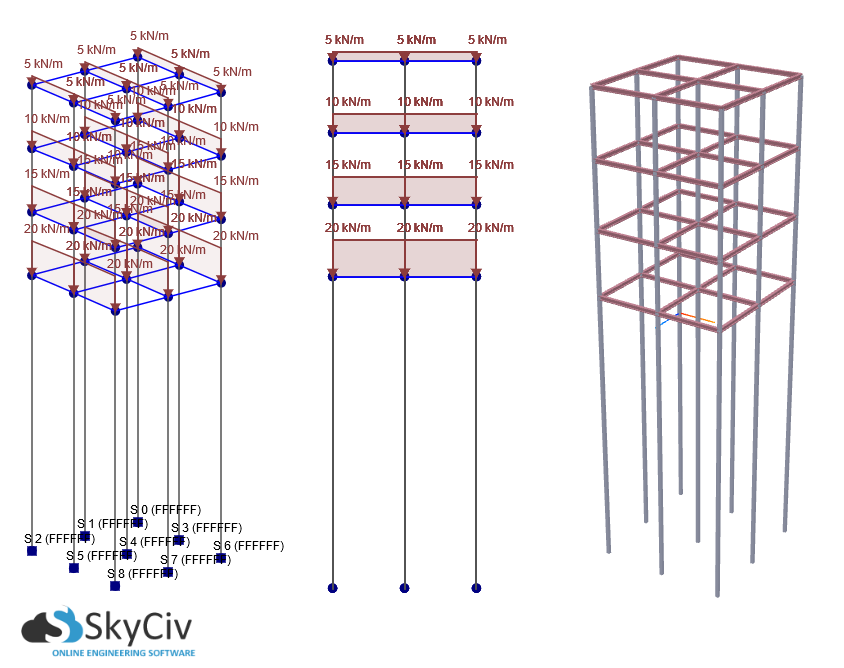 In this example, a linear static analysis (see the left of the image below) shows a maximum total deflection of 4.6mm, a very insignificant value considering the structure is 22m tall. At the base columns, the maximum deflection appears to be around 3.3mm. If a buckling analysis is performed, SkyCiv Structural 3D warns of a buckling factor of 0.98, indicating that the structure is buckling (the factor is less than one). In fact, the buckled shape (shown in red on the right of the image below) shows that the long columns at the base are buckling.
In this example, a linear static analysis (see the left of the image below) shows a maximum total deflection of 4.6mm, a very insignificant value considering the structure is 22m tall. At the base columns, the maximum deflection appears to be around 3.3mm. If a buckling analysis is performed, SkyCiv Structural 3D warns of a buckling factor of 0.98, indicating that the structure is buckling (the factor is less than one). In fact, the buckled shape (shown in red on the right of the image below) shows that the long columns at the base are buckling.
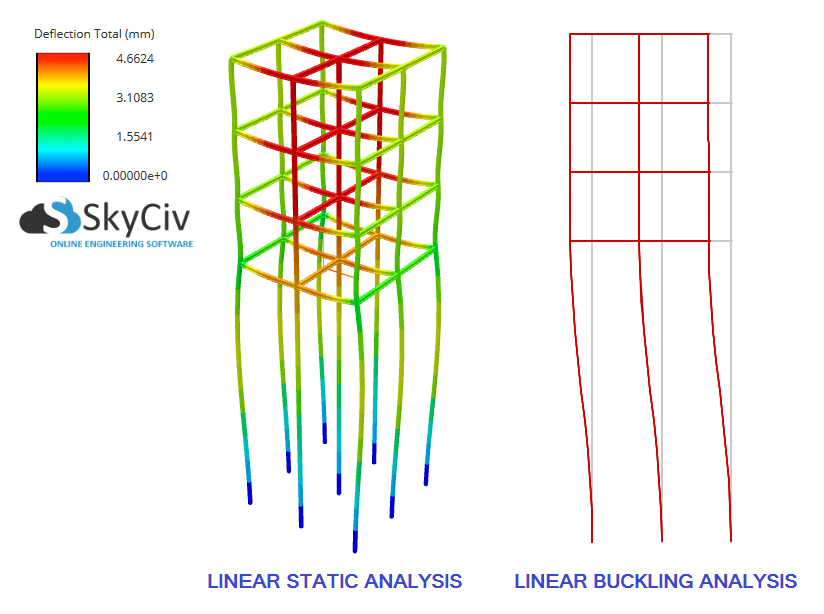 In summary, this example has highlighted the importance of a buckling analysis. Despite a linear static analysis showing only a tiny deflection, the structure was buckling and failing! A buckling analysis should always be performed to check for buckling of slender members under high axial stress because a linear static analysis cannot detect this type of failure. SkyCiv Structural 3D can perform your buckling analysis for you: just hit "Buckling Analysis" when clicking the "Solve" button and let the software do all the hard work for you!
In summary, this example has highlighted the importance of a buckling analysis. Despite a linear static analysis showing only a tiny deflection, the structure was buckling and failing! A buckling analysis should always be performed to check for buckling of slender members under high axial stress because a linear static analysis cannot detect this type of failure. SkyCiv Structural 3D can perform your buckling analysis for you: just hit "Buckling Analysis" when clicking the "Solve" button and let the software do all the hard work for you!
Paul Comino
CTO and Co-Founder of SkyCiv
BEng Mechanical (Hons1), BCom
LinkedIn
CTO and Co-Founder of SkyCiv
BEng Mechanical (Hons1), BCom


